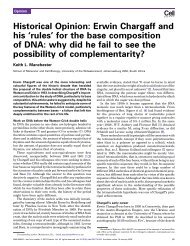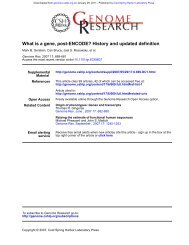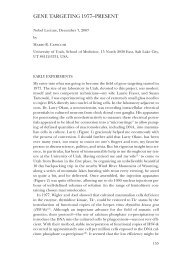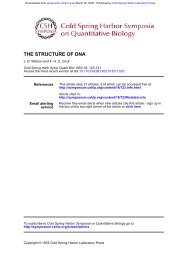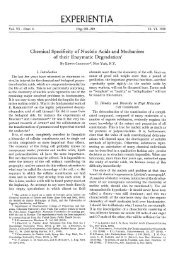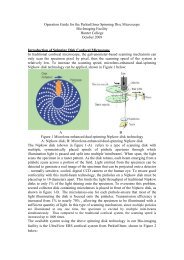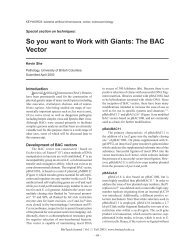Chargaffs Legacy.pdf - Biology
Chargaffs Legacy.pdf - Biology
Chargaffs Legacy.pdf - Biology
- No tags were found...
You also want an ePaper? Increase the reach of your titles
YUMPU automatically turns print PDFs into web optimized ePapers that Google loves.
D.R. Forsdyke, J.R. Mortimer / Gene 261 (2000) 127±137 129pro®le for a genomic region was constructed. Whensequences of much larger genomes became available inthe 1990s, Donald Forsdyke and colleagues showed that awindow of 1 kb can identify more precisely the locations ofgenes (open reading frames) and their transcriptional orientation(Dang et al., 1998; Bell and Forsdyke, 1999a,b; Fig.2). Furthermore, Jean Lobry showed that the relationship tothe origin of replication is a feature of several microbialgenomes (`skew analysis'; Frank and Lobry, 1999; Rochaet al., 1999).Chargaff's main interest in the base cluster phenomenonwas that, prior to the emergence of nucleic acid sequencingtechnology, it provided some measure of the uniqueness ofthe base order of a nucleic acid. Szybalski's main interestwas the possibility that the clustering played a role in thecontrol of transcription. This implied an evolutionaryselection pressure for clustering so that organisms withclusters would better control transcription than organismswhich did not have clusters. However, following a betterunderstanding of Chargaff's second parity rule as a re¯ectionof nucleic acid secondary structure (see Section 3), itwas recognized that in many cases a selection pressure forclustering was likely to have arisen at the post-transcriptionallevel.3. The second parity ruleChargaff's ®rst parity rule for duplex DNA was consistentwith a base on one strand of the Watson-Crick duplexrequiring a complementary base on the other strand of theduplex. By extrapolation, the existence of a parity rule forsingle strands of nucleic acid (Chargaff's second parityrule), suggested intrastrand base pairing. At least by virtueof the composition of the stems in stem-loop secondarystructures there should be an approximate equivalencebetween the Chargaff base pairs. Do genomes have thepotential to form such secondary structures? What adaptiveforces (if any) could have created them? These questionsbegan to be addressed when the genomic sequences ofvarious bacterial viruses (bacteriophages) ®rst becameavailable in the 1970s. It became evident that genomescontain multiple levels of information, and that someforms of information con¯ict with others (Grantham,1972; Grantham et al., 1985, 1986).In some phages the genome is RNA (e.g. R17, MS2), andin others the genome is DNA (e.g. T4). In classical Darwinianterms it was assumed that bacteriophages which encode optimalproteins are best adapted to their environment. Thus, theenvironment acting on virus proteins would have selected forFig. 2. Szybalski's transcription direction rule, evaluated as `Chargaff differences' (deviations from Chargaff's second parity rule). Heavy horizontal arrowsrefer to the `top' and `bottom' strands of duplex DNA. Grey boxes refer to intergenic DNA. Black balls represent RNA polymerases with thin horizontal arrowsindicating the direction of transcription. In the case of leftward transcription the Chargaff difference for the top strand is in favour of pyrimidines (Y). In thecase of rightward transcription the Chargaff difference for the top strand is in favour of purines (R). It follows that RNAs tend to be purine-loaded. Whenapplied to uncharted DNA, Chargaff difference patterns provide clues to the location of genes and their transcriptional orientation.



